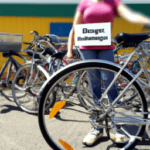Getting involved in cycling advocacy allows you to make streets safer and more accessible for everyone. Support local projects by volunteering, attending community events, and engaging with policymakers. Partner with schools, businesses, and organizations to promote bike-friendly initiatives. Raise funds through events or donations and help build stronger networks for change. By taking these steps, you can create a lasting impact. Keep exploring how you can amplify your efforts and shape a better cycling community.
Key Takeaways
- Join local cycling organizations and participate in advocacy events to support infrastructure and policy changes.
- Engage with policymakers through testimony, petitions, and public forums to promote bike-friendly initiatives.
- Volunteer for community workshops, safety programs, and youth outreach to foster a cycling culture.
- Organize or participate in fundraising rides and events to generate resources for cycling projects.
- Build partnerships with schools, businesses, and community groups to expand bike advocacy and awareness efforts.
Understanding the Impact of Bike Advocacy
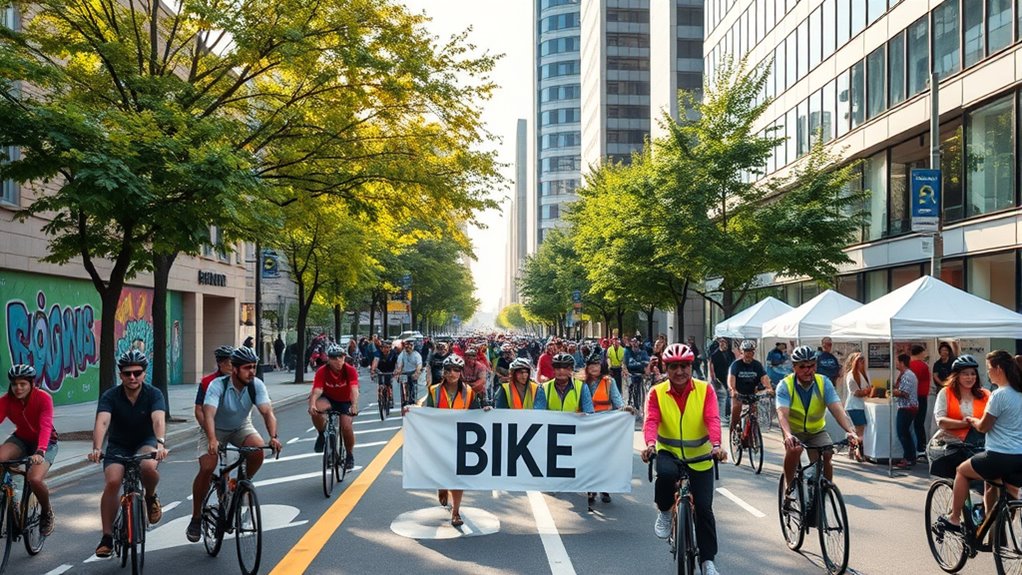
Have you ever wondered how bike advocacy truly shapes your riding environment? When you support bike advocacy, you’re helping create policies that expand bike infrastructure and improve safety. Organizations like MassBike work tirelessly to push for policy change, resulting in more bike lanes, greenways, and safer intersections. These efforts directly boost cycling participation by making riding safer and more accessible. Data shows that communities with strong bike advocacy see fewer accidents and more people choosing bikes for transportation. Plus, your support helps secure funding for projects that benefit everyone—investing millions in cycling infrastructure nationwide. Ultimately, bike advocacy doesn’t just make cycling safer; it promotes public health, environmental sustainability, and economic growth—making your ride better today and for future generations. Effective advocacy also enhances city dynamics, encouraging more inclusive and vibrant urban environments. Supporting bike advocacy can also lead to a positive community impact, fostering social connections and local pride among residents. Building a supportive community is essential since public awareness about cycling benefits has increased significantly due to advocacy efforts. Moreover, increased advocacy often leads to policy improvements that further support safe and accessible cycling options for all. Additionally, strengthened advocacy efforts can influence urban planning to incorporate more sustainable and cyclist-friendly designs, benefiting communities long-term.
Ways to Support Local Cycling Initiatives
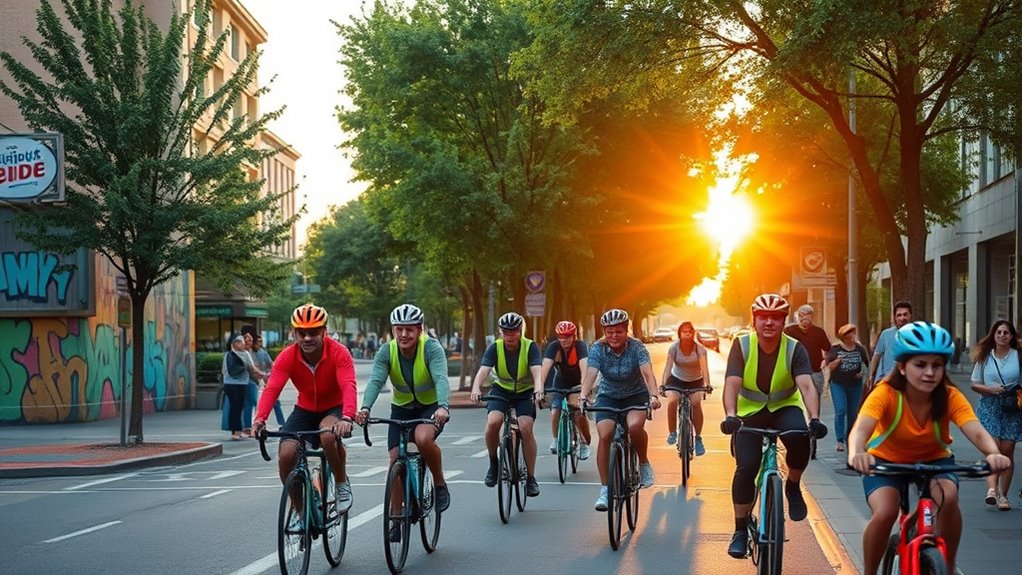
Supporting local cycling initiatives is easier than you think. You can volunteer at events, donate to advocacy campaigns, or speak with policymakers to push for better biking infrastructure. Every action helps build a stronger, safer cycling community. Additionally, advocating for improved cycling infrastructure can encourage more residents to choose biking as a sustainable transportation option.
Volunteer for Events
Volunteering at local cycling events is a powerful way to strengthen community support and promote the benefits of biking. When you volunteer at bike events, safety clinics, or bike rodeos, you help create a welcoming environment that encourages more people to ride. Your assistance with event logistics—such as registration, setup, or handing out materials—ensures everything runs smoothly. Supporting bike repair stations or offering free tune-ups during these events boosts rider confidence and safety. Your involvement also promotes bike safety education, particularly among youth and new riders, helping foster lifelong cycling habits. Additionally, understanding how to identify and address equipment issues can significantly enhance the safety and enjoyment of participants. Developing community cycling networks through your participation can lead to more organized rides and events, further encouraging cycling in your area. Establishing fundraising strategies can also support infrastructure improvements and outreach programs. Building public awareness about cycling benefits is crucial for expanding participation and fostering a bike-friendly culture. By participating as a volunteer, you inspire others to get involved, build local cycling networks, and make a meaningful impact on your community’s cycling culture. Engaging in these activities also helps you gain valuable skills that can be applied to future initiatives and leadership roles within the cycling community.
Donate to Campaigns
Wondering how you can make a lasting impact on your local cycling community? Donations are a powerful way to support advocacy groups working to improve bike safety and infrastructure. Your financial contributions fund essential projects like new bike lanes, safety campaigns, and community programs that make cycling safer and more accessible. Even a $50 donation can provide a helmet for a child, promoting safe riding habits from a young age. Regular giving helps advocacy campaigns sustain long-term policies that create safer streets for cyclists of all ages. Additionally, supporting these initiatives can leverage payment solutions to facilitate easier and more secure contributions. Plus, supporting these initiatives boosts the local economy, which benefits everyone. By donating, you directly help build a stronger, safer, and more inclusive cycling community that encourages more people to ride. Supporting community initiatives can also increase awareness and participation among local residents, further amplifying your impact. Understanding how funding sources are used can help donors see the tangible benefits of their contributions and encourage ongoing support. Engaging with local government can also help ensure that cycling needs are prioritized in urban planning and infrastructure development. Recognizing the importance of spiritual energy can inspire a sense of purpose and community involvement in advocacy efforts.
Advocate With Policymakers
To effectively advocate for better cycling infrastructure, reaching out to local policymakers is essential. Contact advocacy organizations, your city council, or transportation committees through emails, calls, or town hall meetings to express your support for bike projects and policies. Share data and personal stories that highlight cycling’s safety and economic benefits to strengthen your message. Attend city council or transportation committee meetings to push for dedicated funding and bike-friendly initiatives. Participate in public comment periods to influence transportation plans that prioritize cycling. Collaborate with advocacy groups to organize petitions and campaigns, demonstrating strong community support for bike infrastructure. Your active involvement can help shape policies that make cycling safer and more accessible for everyone. Building awareness about effective advocacy strategies can also enhance your efforts. Staying informed about local government decisions regarding transportation can help you respond more effectively to policy changes and funding opportunities. Engaging with community members and fostering public support is also key to creating lasting change in cycling policies.
Organizing Community Events to Promote Biking
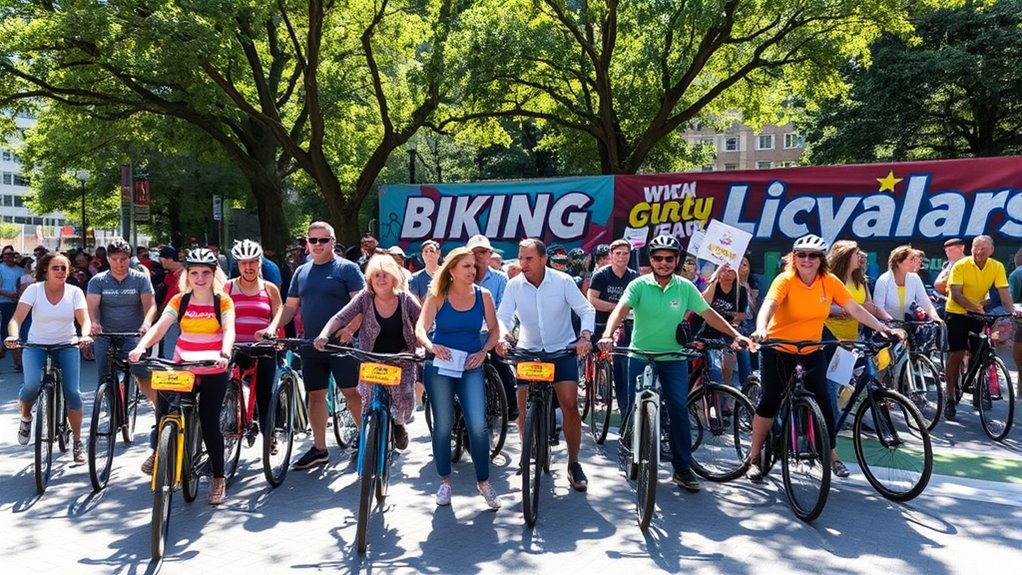
Organizing community biking events is an effective way to encourage more people to ride and highlight the benefits of cycling. By hosting events like bike-to-school days or fun rides, you can increase local participation and boost awareness of biking’s advantages. To guarantee success, secure permits, select accessible routes, and promote the event through social media and local networks. Incorporating safety education and repair workshops not only promotes safe riding habits but also builds community skills. Collaborating with schools, local businesses, and advocacy groups expands outreach and garners broader support for bike advocacy. Data shows that these community events substantially increase bike ridership and help participants develop lifelong cycling habits, making them a crucial tool in promoting biking within your community. Additionally, understanding merchant services can help organizers provide fresh refreshments for participants, enhancing the event experience.
Building Partnerships With Stakeholders
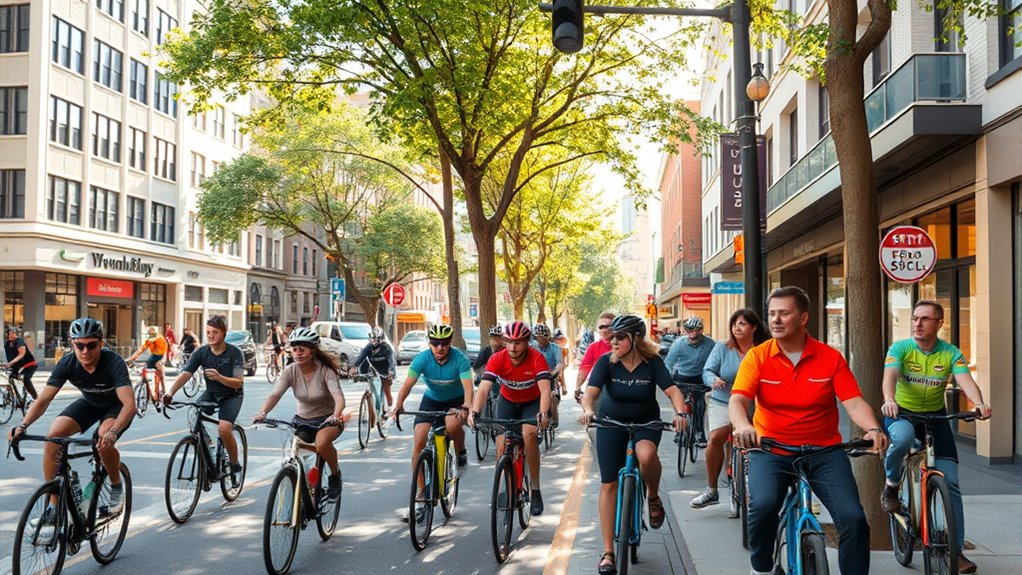
Building strong partnerships with local government, businesses, and community organizations is essential for advancing your bike advocacy efforts. These partnerships help secure funding, support bike infrastructure projects, and promote advocacy initiatives effectively. Engaging stakeholders through regular meetings and public forums ensures community needs are addressed and increases buy-in for bike-friendly policies. Collaborating with schools and youth groups fosters cycling education and safe riding habits among future riders. Partnering with transportation agencies and advocacy groups amplifies your efforts by sharing resources and expertise, creating all-encompassing cycling networks. Establishing alliances with seniors, disability advocates, and employers broadens support and promotes inclusive, accessible biking communities. Strong stakeholder relationships are key to sustainable, impactful cycling advocacy.
Advocating for Better Infrastructure and Policy Changes
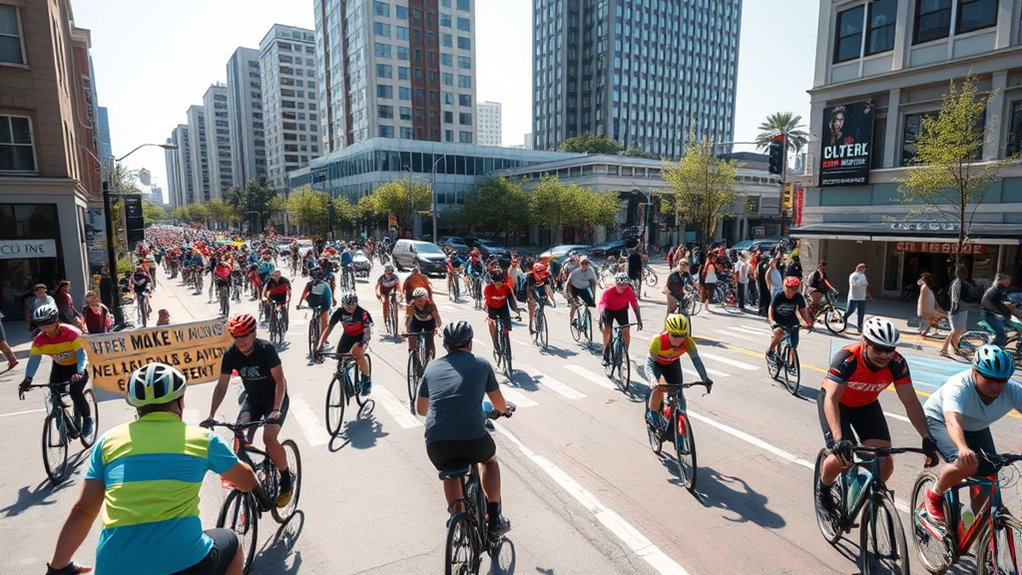
How can you effectively advocate for better cycling infrastructure and policy changes? Start by engaging with city officials and transportation departments to push for improved bike infrastructure like protected bike lanes, greenways, and safe intersections. Highlight data showing that protected bike facilities can cut crashes by up to 90%, emphasizing safety. Mobilize your community through public meetings, petitions, and testimony to support policy change, stressing how investing in bike infrastructure boosts local economies—each dollar spent yields about four dollars in benefits. Building coalitions with local groups amplifies your influence and helps secure funding. Monitor city planning and repaving schedules to time infrastructure improvements strategically. Using data on cycling safety and environmental benefits strengthens your case for lasting policy reforms supporting bike-friendly standards.
Engaging Youth and Educating New Riders
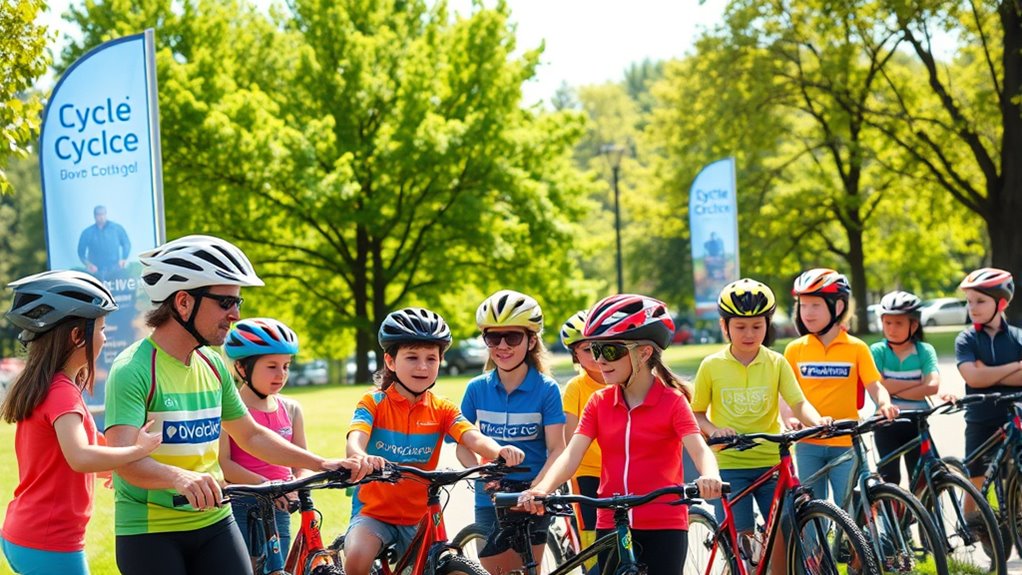
Did you know that engaging youth in cycling initiatives can considerably boost community safety and environmental awareness? By promoting youth engagement through bicycle education, you help develop confident, responsible riders. Organize bike safety and repair workshops at schools or community centers to teach new riders essential skills. Incorporate bicycle education classes into school curricula to cover traffic laws, helmet use, and safe riding practices. Encourage creative projects like customizing bikes and helmets with stickers and art to foster enthusiasm. You can also support bike bus programs for students, making cycling a fun and eco-friendly commute. These efforts not only improve bike safety but also nurture a positive cycling culture among young riders, ensuring a safer, more inclusive community for everyone.
Raising Funds and Growing Your Advocacy Network
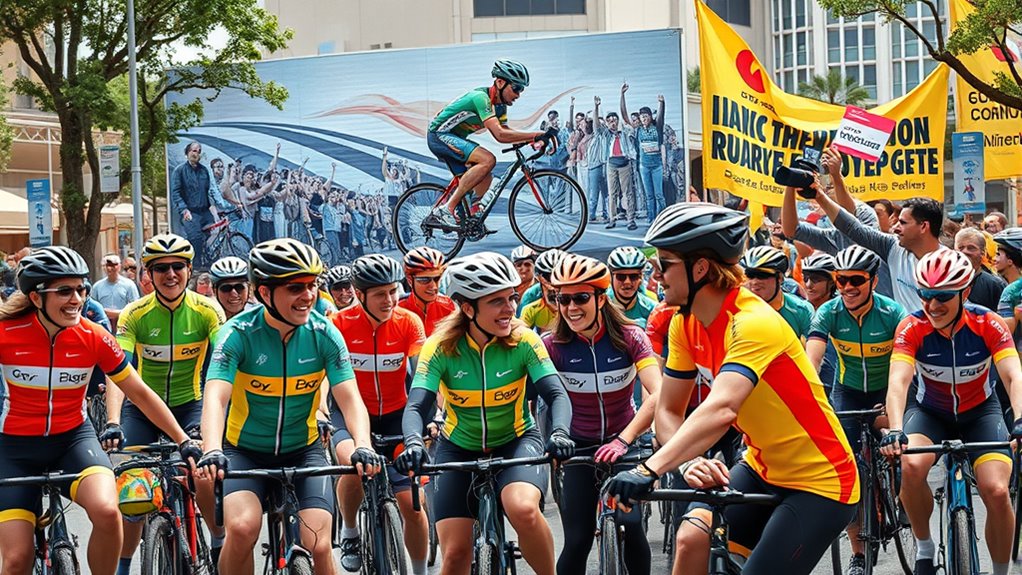
Raising funds and expanding your advocacy network are crucial steps to creating a sustainable and impactful cycling community. You can organize fundraising rides and bike events that generate significant support for bike infrastructure and advocacy programs. Reach out to local businesses and community organizations for sponsorships and donations, emphasizing cycling’s $96 billion annual economic impact. Building a diverse advocacy network involves recruiting volunteers, community leaders, and cycling enthusiasts through social media campaigns and local outreach. Use resources like PeopleForBikes guides to develop effective fundraising strategies and grow your supporter base. Hosting community bike events and workshops encourages participation, strengthens relationships, and helps sustain momentum for your cause. Focused efforts in fundraising and network expansion are key to long-term cycling advocacy success.
Frequently Asked Questions
What Is the 75 Rule in Cycling?
The 75 Rule in cycling states you should stay at least 75 feet behind large vehicles like trucks and buses. This distance helps drivers see you clearly, minimizes blind spot risks, and gives them enough space to react if you suddenly stop or turn. By following this rule, you improve your safety on busy roads and make sharing the road safer for everyone. Always keep this distance for better visibility and protection.
What Is Bike Advocacy?
Did you know that cities with strong bike advocacy see a 30% increase in cycling? Bike advocacy is all about working to improve cycling conditions, safety, and infrastructure. You can get involved by supporting local organizations, sharing your ideas, and advocating for better bike lanes and safety measures. Your efforts help make cycling more accessible and enjoyable for everyone, reducing traffic, emissions, and boosting public health.
What Body Shape Does Cycling Give You?
Cycling gives you a lean, toned physique by burning calories and reducing body fat. It mainly targets your legs, hips, and glutes, shaping a muscular lower body. With consistent effort, you’ll develop a more elongated, athletic look, thanks to muscle definition and better posture. Your body shape will become more balanced and proportionate over time, creating a fitter, more sculpted appearance that reflects your dedication to cycling.
How to Encourage People to Use Bicycles?
You can encourage people to use bicycles by highlighting that bike riders cut commute times by up to 25%, making their trips faster and more efficient. Organize fun events like bike-to-work days or festivals to create positive experiences. Make biking easier with secure bike parking at key locations, and share the health benefits, like burning 300 calories in 30 minutes. Emphasize how cycling reduces CO2 emissions, appealing to eco-conscious individuals.
Conclusion
Getting involved in cycling advocacy truly makes a difference. For example, imagine organizing a community ride that sparks local support and leads to new bike lanes. Every effort—whether supporting initiatives, educating others, or building partnerships—helps create safer, more bike-friendly neighborhoods. So, step up today. Your passion can inspire change, improve safety, and encourage more people to enjoy the benefits of biking. Together, you can make a lasting impact on your community.



